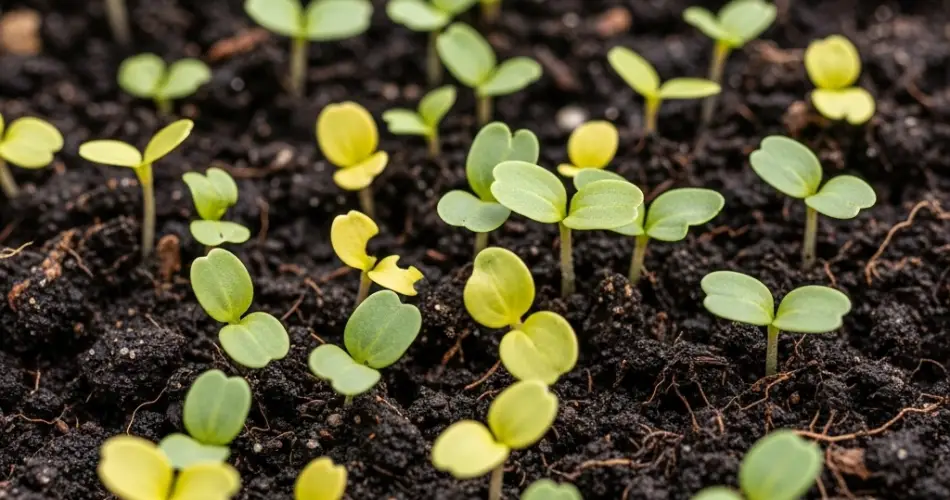If you want strong, healthy, and productive seedlings, especially for popular garden crops like tomatoes and cucumbers, one of the most important steps is providing the right nutrients early on. While many gardeners reach for chemical fertilizers, there’s a simple, effective, and entirely natural solution that gives your young plants a powerful start — and you likely already have it at home.
This article reveals one of the strongest natural fertilizers you can use to nourish seedlings and promote robust growth from the very beginning. It works exceptionally well for vegetables like tomatoes, cucumbers, peppers, and even greens — all without synthetic chemicals or expensive commercial products.
Why Seedlings Need Fertilizer
Seedlings start life with limited resources stored in the seed itself. Once they’ve germinated and produced their first set of true leaves, they begin to rely on external nutrients to grow stronger roots, stems, and leaves.
At this stage, a balanced, gentle fertilizer helps:
-
Develop a strong root system
-
Build sturdy stems and lush foliage
-
Prevent early nutrient deficiencies
-
Prepare the plant for transplanting into open ground or containers
Without adequate nutrition, seedlings may become weak, spindly, and more vulnerable to stress, pests, and disease.
The Best Natural Fertilizer: Yeast Solution
Surprisingly, ordinary baker’s yeast is one of the most effective and accessible natural fertilizers for seedlings. While not a complete fertilizer by itself, yeast provides a powerful boost to young plants by stimulating root development, enhancing microbial activity in the soil, and helping plants absorb nutrients more efficiently.
Yeast contains:
-
B vitamins – essential for energy production in plant cells
-
Amino acids – help in the building of proteins for healthy plant tissue
-
Growth hormones – naturally stimulate development
-
Enzymes – improve soil microflora and nutrient cycling
Yeast also acts as a natural biostimulant, encouraging stronger and faster seedling growth with greater resilience.
How to Prepare Yeast Fertilizer
Making this natural fertilizer is simple and inexpensive. Here’s how:
Ingredients:
-
10 grams of fresh baker’s yeast (or 1 teaspoon of dry yeast)
-
1 tablespoon of sugar
-
1 liter of warm (not hot) water
Instructions:
-
Dissolve the yeast and sugar in the warm water.
-
Let the mixture sit for 2–3 hours in a warm place until bubbles form. This shows that the yeast is active.
-
Dilute the mixture with 4–5 liters of clean water before using.
-
Use immediately for best results.
How to Apply Yeast Fertilizer to Seedlings
-
Timing: Begin applying once seedlings have developed their first set of true leaves.
-
Application method: Water the soil around the base of each seedling gently with the diluted yeast solution. Avoid wetting the leaves.
-
Frequency: Apply once every 10–14 days until transplanting.
This solution is safe, natural, and particularly effective when used in moderation. Overuse is unnecessary and may lead to excess microbial activity that can temporarily reduce soil nitrogen levels.
Why It Works Especially Well for Tomatoes and Cucumbers
Tomatoes and cucumbers are fast-growing plants with high nutrient demands. Using yeast as an early fertilizer supports:
-
Strong root systems, essential for healthy transplants
-
Thick, green foliage, which helps photosynthesis
-
Faster early growth, shortening the time to flowering and fruiting
-
Greater resistance to transplant shock and early disease
Because this fertilizer is all-natural and gentle, it won’t burn tender young roots like some synthetic products might.
Pair With Other Natural Fertilizers
While yeast is excellent for promoting seedling growth, it works best as part of a holistic, organic feeding routine. For more balanced nutrition, combine with:
-
Wood ash (for potassium and calcium)
-
Banana peel tea (for potassium and phosphorus)
-
Crushed eggshells (for calcium)
-
Compost tea (for a broader range of nutrients)
These additions can be introduced gradually after the seedling stage, particularly after transplanting into the garden or larger containers.
Other Tips for Healthy Seedlings
To get the most out of any fertilizer, remember:
-
Use clean containers and sterile seed-starting mix to avoid fungal diseases.
-
Provide adequate light — at least 12–14 hours per day under grow lights or bright natural light.
-
Maintain consistent moisture, keeping soil damp but not soggy.
-
Transplant seedlings gently once they are strong enough and have 3–4 sets of leaves.
Final Thoughts
A tablespoon of natural yeast fertilizer may not seem like much, but its effects on young plants can be remarkable. For gardeners looking to boost their tomatoes, cucumbers, and other vegetable seedlings naturally, yeast offers an effective and affordable solution.
Strong, healthy seedlings lay the foundation for a productive garden season. With the help of this powerful natural fertilizer, you’ll give your plants the best possible start — and reap the rewards later with a rich, flavorful harvest.



